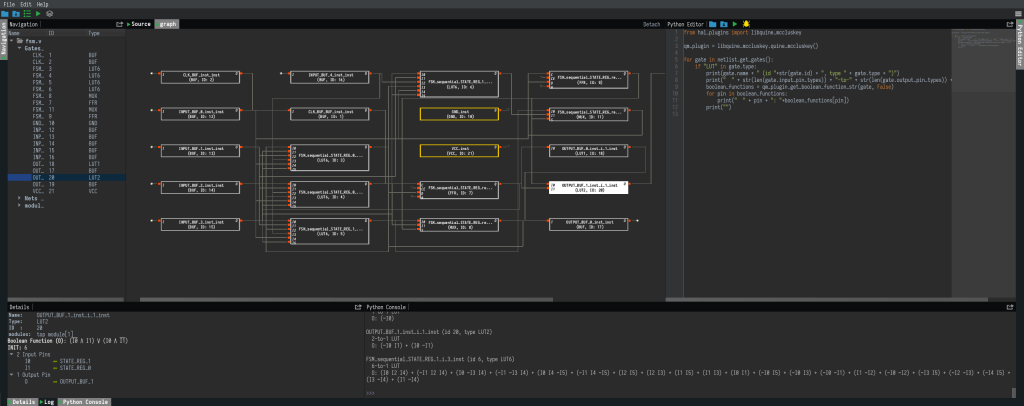HAL is a comprehensive reverse engineering and manipulation framework for gate-level netlists focusing on efficiency, extendability and portability. HAL comes with a fully-fledged plugin system, allowing to introduce arbitrary functionalities to the core.
Apart from multiple research projects, HAL is also used in our university lecture Introduction to Hardware Reverse Engineering.
Features
- Natural directed graph representation of netlist elements and their connections
- Support for custom gate libraries
- High performance thanks to optimized C++ core
- Modularity: write your own C++ Plugins for efficient netlist analysis and manipulation (e.g. via graph algorithms)
- A feature-rich GUI allowing for visual netlist inspection and interactive analysis
- An integrated Python shell to exploratively interact with netlist elements and to interface plugins from the GUI
- Update v1.1.0 Support for Xilinx Unisim, Xilinx Simprim, Synopsys 90nm, GSCLIB 3.0 and UMC 0.18µm libraries is now added
API Documentation
The C++ documentation is available here. The Python documentation can be found here.
Salamandra – Spy Microphone Detection Tool
Quick Start
Install or build HAL and start the GUI via hal -g. You can list all available options via hal [--help|-h]. We included some example netlists in examples together with the implementation of the respective example gate library in plugins/example_gate_library. For instructions to create your own gate library and other useful tutorials, take a look at the wiki.
Load a library from the examples directory and start exploring the graphical representation. Use the integrated Python shell or the Python script window to interact. Both feature (limited) autocomplete functionality.
Let’s list all lookup tables and print their Boolean functions:
from hal_plugins import libquine_mccluskey
qm_plugin = libquine_mccluskey.quine_mccluskey()
for gate in netlist.get_gates():
if "LUT" in gate.type:
print(gate.name + " (id "+str(gate.id) + ", type " + gate.type + ")")
print(" " + str(len(gate.input_pin_types)) + "-to-" + str(len(gate.output_pin_types)) + " LUT")
boolean_functions = qm_plugin.get_boolean_function_str(gate, False)
for pin in boolean_functions:
print(" " + pin + ": "+boolean_functions[pin])
print("")
For the example netlist fsm.vhd this prints:
FSM_sequential_STATE_REG_1_i_2_inst (id 5, type LUT6)
6-to-1 LUT
O: (~I0 I1 ~I2 I3 I4 ~I5) + (I0 ~I2 I3 I4 I5)
FSM_sequential_STATE_REG_0_i_2_inst (id 3, type LUT6)
6-to-1 LUT
O: (I2 I3 I4 ~I5) + (I1 I2) + (I0 I1) + (I1 ~I3) + (I1 ~I4) + (I1 ~I5)
FSM_sequential_STATE_REG_0_i_3_inst (id 4, type LUT6)
6-to-1 LUT
O: (~I1 ~I2 I3 ~I4 I5) + (I0 I5) + (I0 I4) + (I0 I3) + (I0 I1) + (I0 ~I2)
OUTPUT_BUF_0_inst_i_1_inst (id 18, type LUT1)
1-to-1 LUT
O: (~I0)
OUTPUT_BUF_1_inst_i_1_inst (id 20, type LUT2)
2-to-1 LUT
O: (~I0 I1) + (I0 ~I1)
FSM_sequential_STATE_REG_1_i_3_inst (id 6, type LUT6)
6-to-1 LUT
O: (I0 I2 I4) + (~I1 I2 I4) + (I0 ~I3 I4) + (~I1 ~I3 I4) + (I0 I4 ~I5) + (~I1 I4 ~I5) + (I2 I5) + (I2 I3) + (I1 I5) + (I1 I3) + (I0 I1) + (~I0 I5) + (~I0 I3) + (~I0 ~I1) + (I1 ~I2) + (~I0 ~I2) + (~I3 I5) + (~I2 ~I3) + (~I4 I5) + (I3 ~I4) + (I1 ~I4)
Citation
If you use HAL in an academic context, please cite the framework using the reference below:
@misc{hal,
author = {{EmSec Chair for Embedded Security}},
publisher = {{Ruhr University Bochum}},
title = {{HAL - The Hardware Analyzer}},
year = {2019},
howpublished = {url{https://github.com/emsec/hal}},
}
Feel free to also include the original paper
@article{2018:Fyrbiak:HAL,
author = {Marc Fyrbiak and
Sebastian Wallat and
Pawel Swierczynski and
Max Hoffmann and
Sebastian Hoppach and
Matthias Wilhelm and
Tobias Weidlich and
Russell Tessier and
Christof Paar},
title = {{HAL-} The Missing Piece of the Puzzle for Hardware Reverse Engineering,
Trojan Detection and Insertion},
journal = {IEEE Transactions on Dependable and Secure Computing},
year = {2018},
publisher = {IEEE},
howpublished = {url{https://github.com/emsec/hal}}
}
Install Instructions
Ubuntu
HAL releases are available via it’s own ppa. You can find it here: ppa:sebastian-wallat/hal
macOS
Use the following commands to install hal via homebrew.
brew tap emsec/hal
brew install hal
Build Instructions
Run the following commands to download and install HAL.
git clone https://github.com/emsec/hal.git && cd hal- To install all neccessary dependencies execute
./install_dependencies.sh mkdir build && cd buildcmake ..make
Optionally you can install HAL:
make install
Build on macOS
Please make sure to use a compiler that supports OpenMP. You can install one from e.g. Homebrew via: brew install llvm.
To let cmake know of the custom compiler use following command.
cmake .. -DCMAKE_C_COMPILER=/usr/local/opt/llvm/bin/clang -DCMAKE_CXX_COMPILER=/usr/local/opt/llvm/bin/clang++
Run static checks and clang format locally
To install clang-format hook install git-hooks and run:
git hooks --install
Start Docker build via: docker-compose run --rm hal-build
Generate Changelog
git log $(git describe --tags --abbrev=0)..HEAD --pretty=format:"%s" --no-merges
HAL Hardware Analyzer Screenshot

d








